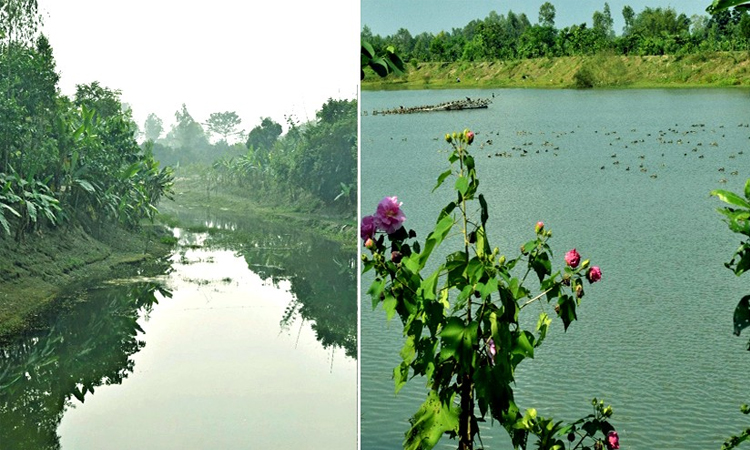
By Md Mamun Islam
RANGPUR, Dec 24, 2024 (BSS) - Implementation of the 'Expansion of irrigation in greater Rangpur district through best uses of surface water and conservation of rainwater (EIR)' project has brought multifaceted benefits to people in Rangpur region.
Along with increasing crop production and improving livelihoods, re-excavation of extinct rivers, canals, beels and ponds under the project is reviving the lost ecosystems, improving the environment and creating natural attractiveness.
In addition, sufficiently stored rainwater in these re-excavated reservoirs is contributing to reloading groundwater tables and conserving surface water and its best possible use in agriculture and household activities.
All these have become possible following implementation of the government's five-year term (2019-2025) EIR project in 35 upazilas of Rangpur, Nilphamari, Kurigram, Lalmonirhat and Gaibandha districts.
Barind Multipurpose Development Authority (BMDA) under the Ministry of Agriculture is implementing the project spending Taka 288.11 crore.
Thousands of people are reaping multidimensional benefits from the project through promoting agriculture, pisciculture, tree plantation, farming vegetables, banana and grass to feed cattle heads and rearing ducks to improve livelihoods.
With the arrival of winter, the entire wetland of the reclaimed reservoirs is now creating a spectacular scene with the chirping of various guest birds and the presence of large trees of rare species on the banks.
Talking to BSS, Project Director of the EIRP and Superintending Engineer of BMDA for Rangpur Circle Engineer Habibur Rahman Khan said thousands of people have started enjoying huge benefits from implementation of the project.
The project is being implemented to promote agriculture making best use of conserved surface water, forestation and improve environment and biodiversity and revive ecosystems and sanctuaries for indigenous fish, insects, local and migratory birds.
"Under the project, re-excavation of extinct rivers, canals, beels and ponds, installation of low lift pumps, solar power-run dug-wells and construction of foot-over bridges and cross dams and tree plantation are being implemented," Khan said.
Re-excavation of these water bodies increases water holding capacity, facilitates drainage of rain and floodwater and waterlogged lands become suitable for agriculture and stored water is being used for agricultural, household and other activities.
Farmers are providing supplementary irrigation to croplands using conserved surface water in re-excavated water bodies reducing dependence on groundwater and producing more crops at lower cost to earn extra profits.
The project has also created facilities for using renewable solar energy in irrigating croplands, increasing cultivation of less water consuming crops utilising water from dug-wells and enhancing forest resources.
"Implementation of the project is expected to be completed within the scheduled time by the June next year," he added.
Talking to BSS recently, local people expressed pleasure saying that they are witnessing revival of the lost ecosystems in the re-excavated water bodies with fresh environment again after three to four decades.
Farmer Harun Ur Rashid of village Jharpara in Badarganj upazila of Rangpur said re-excavation of the extinct river Mora Teesta has revived water flow in the river improving drainage of rain and floodwater to free vast areas from water logging.
"The re-excavated river carried out rainwater swiftly to the river Jamuneswari in the last couple of years freeing my two hectares of land from water-logging and enabling me in cultivating Aman rice on the land for the first time in recent decades," he said.
Housewife Hosne Begum of village Jharpara in the same upazila said she is improving livelihoods by rearing ducks and farming banana and vegetables following re-excavation of the river Mora Teesta.
Farmer Nezamul Haque of village South Bishnupur in the same upazila said he never thought that his one hectare of land might become free from water-logging and cultivable again.
"Re-excavation of the extinct river Ghirnoi has freed my land from water-logging," he said, adding that he is now cultivating three crops on the land annually like many other farmers after three decades.
Nur Mohammad, Anwar Ali and Mohammad Hameem of nearby Kuthipara village said they are fishing in the re-excavated river Ghirnoi where nature has become densely green following plantation of tree saplings on the banks.
Meanwhile, a sight beholding landscape has been created following re-excavation of the Bharardaho Beel along with plantation of 213 species of rare wood, fruit, medicinal and flower plants on its 100-feet wide bank in Badarganj upazila of Rangpur.
Atiar Rahman of nearby village Dangapara said, the whole Beel area, with some 6,000 trees on its banks, is now covered with the chirping of thousands of guest birds and free movement of their wings attracting everybody.
The Beel with abundantly growing flora and fauna has become a sanctuary for birds in revived ecosystems and people are rushing there also to enjoy the beauty of green nature and budding flowers.